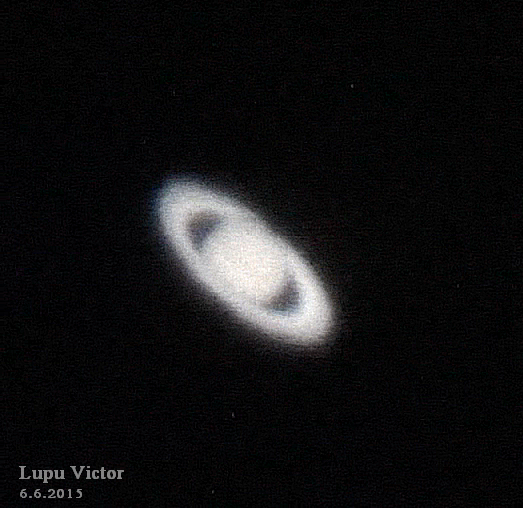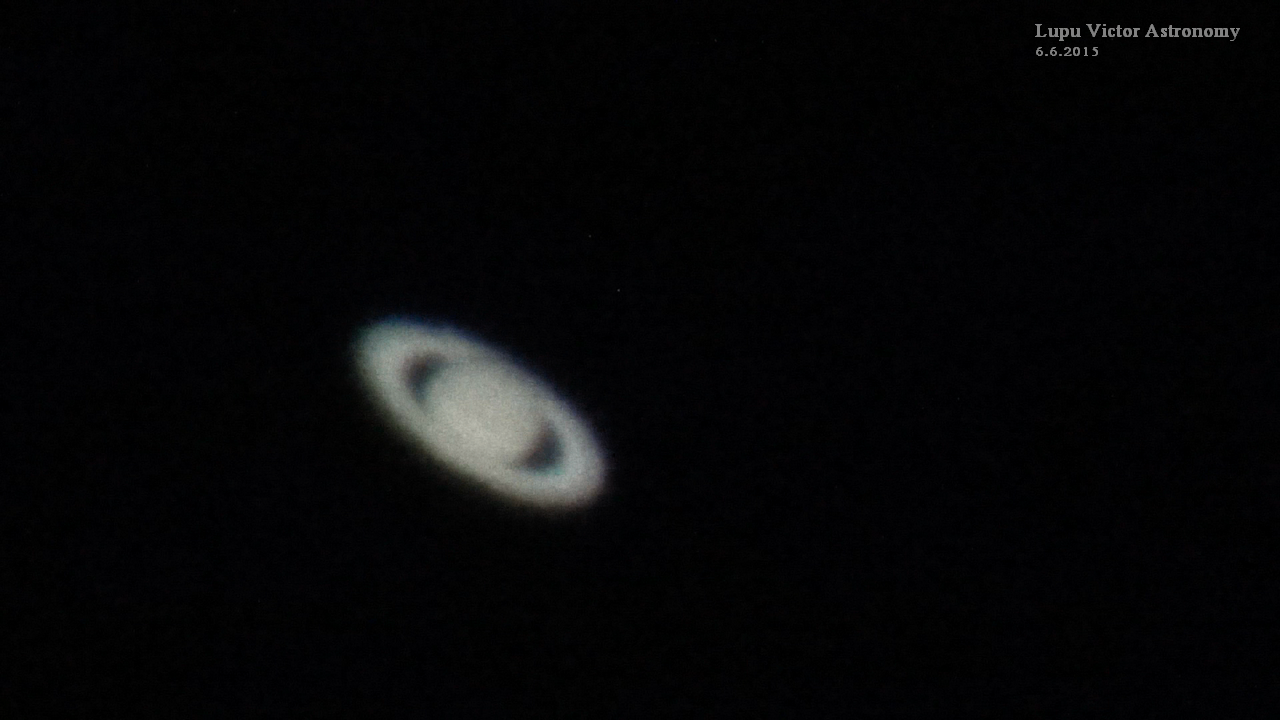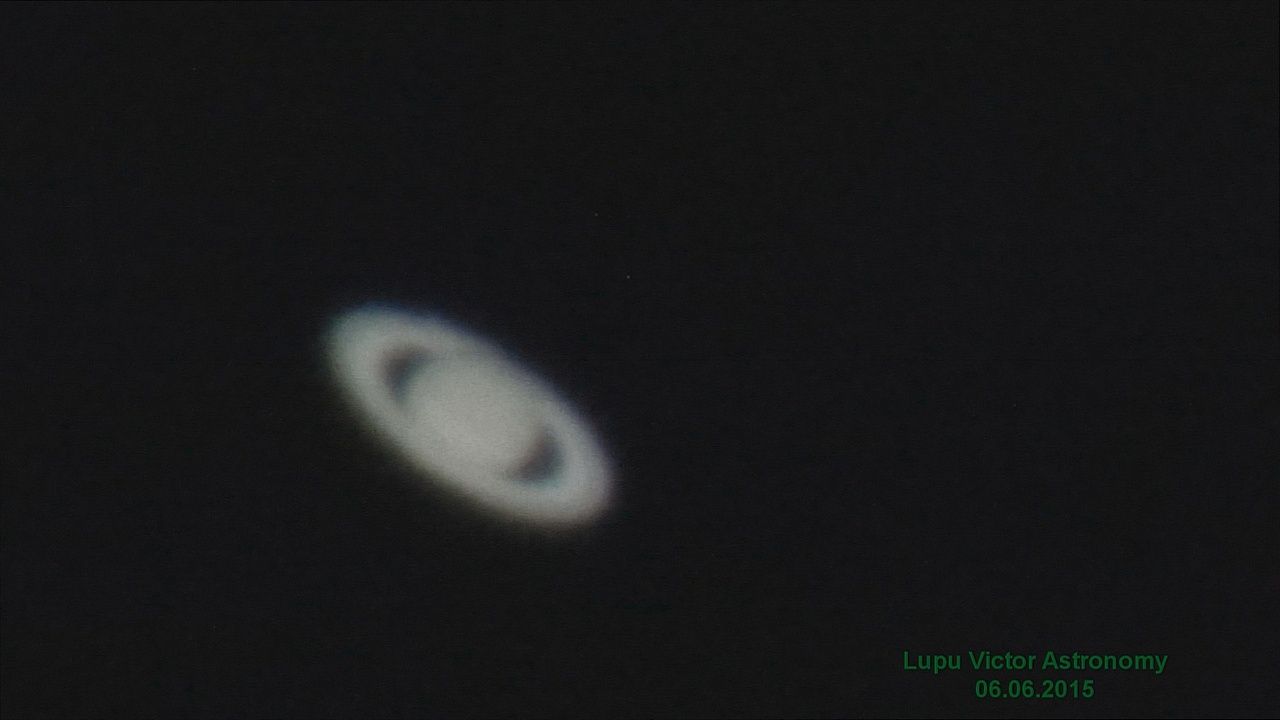In these images we see that Saturn at this time appears inclined towards in the night sky seen from Earth through an astronomical telescope. This angle of this planet is new to me. There are moments of clarity revealing important features such as the division of Cassini, which represents a pause between rings. The planet Saturn does not have so manyfeatures on its surface like Jupiter, another gaseous planet, but in some moments are distinct several distinct shades.
Cassini division separates the inner wider B ring and the outer A ring, which can be observed in some of these images below.
In 1675, Giovanni Domenico Cassini determined that Saturn's ring is composed of multiple smaller rings with gaps between them; the largest of these gaps was later named the Cassini Division. This division is a region 4,800 km wide between ring A and B.
Saturn is the 6th planet from our Sun.Because the large mass and the gravity, Saturn has extreme conditions when compared to Earth.The interior is probably composed of an iron-based compounds, nickel, silicon and oxygen surrounded by a deep layer of metallic hydrogen, a layer of liquid hydrogen and liquid helium, and finally, a gaseous outer layer.
Saturn is a planet known in antiquity as it is one of the five planets visible with the naked eye.
Galileo Galilei, first observed Saturn's rings through a telescope in 1610. He first described the planet as having "handles". Later, because of his telescope aberrations, he thought that the rings are two twin moons orbiting around the planet.
In our times, being a popular scientific instrument, the telescope can be used to observe Saturn's rings, and with the new video and photo cameras, can be achieved exceptional astrophotos and clips of this planet.
The average distance between Saturn and the Sun is over 1.4 billion km (9 AU). With an average orbital speed of 9.69 km / s Saturn needs 10.759 days (or about 29 years and a half), to complete one revolution around the sun.
Elliptical orbit of Saturn is inclined 2.48 ° relative to the Earth's orbital plane. Because of eccentricity of 0056. the distance between Saturn and the Sun varies by about 155,000,000 km between perihelion and aphelion, wich is the closest and most distant planet in its orbit along the way.
General data:
10.11595804 AU Aphelion (1,513,325,783 km)
9.04807635 AU Perihelion (1,353,572,956 km)
Orbital period 29.4571 years or 10759.22 days (24491.07 Saturn solar days)
Polar Radius 54,364 ± 10 km (8.5521 Earths)
Surface area 4.27 × 1010 km2 (83 703 Earths)
Equatorial rotation speed 9.87 km / s (35,500 km / h)
Axial tilt 26.73 °
Photos of Saturn through the astronomical telescope. The images were obtained by attaching a video camera directly into an astronomical telescope's eyepiece; for this reason, the eyepiece's visual field was enhanced. These are simple video captures.
Planet: Saturn
Magnitude: 0.30
Distance: 8.99 AU (1,344,884,857 km)
Lighting: 100%
Astronomical Instrument: Celestron C8-Newtonian telescope, 20mm Plossl, 2x Barlow
Mount: CG5 (EQ5)
Camera: Sony CX130
Filter: no
Date: 06/06/2015
Location: Baia Mare, Romania
Processing: FastStone Image Viewer
Cassini division separates the inner wider B ring and the outer A ring, which can be observed in some of these images below.
In 1675, Giovanni Domenico Cassini determined that Saturn's ring is composed of multiple smaller rings with gaps between them; the largest of these gaps was later named the Cassini Division. This division is a region 4,800 km wide between ring A and B.
Saturn is the 6th planet from our Sun.Because the large mass and the gravity, Saturn has extreme conditions when compared to Earth.The interior is probably composed of an iron-based compounds, nickel, silicon and oxygen surrounded by a deep layer of metallic hydrogen, a layer of liquid hydrogen and liquid helium, and finally, a gaseous outer layer.
Saturn is a planet known in antiquity as it is one of the five planets visible with the naked eye.
Galileo Galilei, first observed Saturn's rings through a telescope in 1610. He first described the planet as having "handles". Later, because of his telescope aberrations, he thought that the rings are two twin moons orbiting around the planet.
In our times, being a popular scientific instrument, the telescope can be used to observe Saturn's rings, and with the new video and photo cameras, can be achieved exceptional astrophotos and clips of this planet.
The average distance between Saturn and the Sun is over 1.4 billion km (9 AU). With an average orbital speed of 9.69 km / s Saturn needs 10.759 days (or about 29 years and a half), to complete one revolution around the sun.
Elliptical orbit of Saturn is inclined 2.48 ° relative to the Earth's orbital plane. Because of eccentricity of 0056. the distance between Saturn and the Sun varies by about 155,000,000 km between perihelion and aphelion, wich is the closest and most distant planet in its orbit along the way.
General data:
10.11595804 AU Aphelion (1,513,325,783 km)
9.04807635 AU Perihelion (1,353,572,956 km)
Orbital period 29.4571 years or 10759.22 days (24491.07 Saturn solar days)
Polar Radius 54,364 ± 10 km (8.5521 Earths)
Surface area 4.27 × 1010 km2 (83 703 Earths)
Equatorial rotation speed 9.87 km / s (35,500 km / h)
Axial tilt 26.73 °
Photos of Saturn through the astronomical telescope. The images were obtained by attaching a video camera directly into an astronomical telescope's eyepiece; for this reason, the eyepiece's visual field was enhanced. These are simple video captures.
Planet: Saturn
Magnitude: 0.30
Distance: 8.99 AU (1,344,884,857 km)
Lighting: 100%
Astronomical Instrument: Celestron C8-Newtonian telescope, 20mm Plossl, 2x Barlow
Mount: CG5 (EQ5)
Camera: Sony CX130
Filter: no
Date: 06/06/2015
Location: Baia Mare, Romania
Processing: FastStone Image Viewer




 Tuesday, June 16, 2015
Tuesday, June 16, 2015
 Unknown
Unknown















 Posted in:
Posted in: 


1 comments:
There are plenty homework help websites, but i recommend using this one. Its proved to be reliable.
Post a Comment